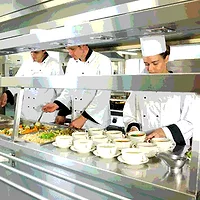Reducing Food Safety Risks in Transporting Food
Although many challenges affect transporting food safely, two stand out across industries: cross-contamination and food defense

Image credit: Nes/E+ via Getty Images
In a dynamic shipping environment, the need to anticipate and reduce food safety risks across the supply chain requires innovation, strategic leadership, and strong partnerships between food and transportation companies. The sanitary transport of human and animal food rules by the U.S. Food and Drug Administration (FDA),1 the safety and security guidelines for transportation by the U.S. Department of Agriculture's Food Safety and Inspection Service (USDA's FSIS),2 and food defense guidance from both agencies3,4 are only one part of ensuring that food and feed are transported safely throughout the supply chain, from farm to fork. Understanding the current trends and innovations that have advanced food safety systems as we know and rely on them today is critical to developing the next innovations and partnerships in transporting food safely.
History of Transporting Food Safely
Cargill has been the leader in several innovations related to making the transport of grains around the world more efficient and effective. A new barge and tugboat design in the 1930s used steel cables to connect vessels, allowing for more agility, speed, and cargo space while moving grain on rivers. The barge would be enlarged, measuring close to the width of the locks, and cast in a single-skin steel instead of wood. In 1966, Illinois Central Railroad sought a partner for an innovative idea, the "unit train." The idea entailed an entire unit train being rented by a single company. Cargill jumped at the opportunity.
However, this meant that Cargill needed to gather an unheard-of amount of grain—enough to fill more than 100 cars. To protect the integrity and quality of the grain in this new system, Cargill also developed aeration equipment and dryers to store grain, keeping it in prime condition well beyond harvest. The unit train reduced rail costs by 50 percent and helped farmers get their grain to market. More recently, Cargill has partnered with global shipping leaders to utilize wind energy and sails to power ships across the ocean. The use of sails will help reduce emissions by as much as 30 percent, which equates to approximately 6,400 metric tons of carbon dioxide per year.5
Although not as glamorous, numerous advancements have been made in protecting food during transportation across supply chains. Before Frederick McKinley Jones' patent in 1939, perishable foods were cooled by salt and ice while being transported, which lacked standardized best practices and required extra labor to maintain.6 Jones' refrigerating invention was mounted to the front side of the trailer and mechanically conditioned the air—tempering, humidifying, and circulating to consistently refrigerate a shipment. In the early days, flour bags and other food commodities were shipped in open trailers, often exposing them to the elements and dust from dirt roads. Today, enclosed trailers that are sealed to protect shipments from the elements and tampering are now the norm for safely transporting food.
And then there is bulk shipping. Before the onset of bovine spongiform encephalopathy (BSE) in the cattle industry, not much thought was given to the other commodities that may have been in a bulk shipping container destined for animal food or feed. To prevent the spread of BSE, regulators instituted new regulations prohibiting certain animal proteins in ruminant feed, and the animal food and feed industry began to inspect prior commodities on bulk shipments.7
Even with great innovations and advances in regulations, the safe transport of food across industries has not been without its challenges. From an outbreak of Salmonella in pasteurized ice cream due to insanitary trailer cars8 to a fungicide-related public health issue associated with contaminated pallets in Europe,9 transportation issues have a long history of food safety-related challenges.
Current Trends in Food Transport
Although many challenges affect transporting food safely, two stand out across industries: cross-contamination and food defense. Continued efforts to innovate and partner across industry will ensure that these trends are appropriately managed to reduce or eliminate a food safety hazard.
Looking for quick answers on food safety topics?
Try Ask FSM, our new smart AI search tool.
Ask FSM →
Cross-Contamination1,2
Cross-contamination while transporting food comes in many forms. What may appear to be a minor issue or a non-event can lead to the adulteration of food. Understanding sources of contamination will support the development of a robust risk assessment to either prevent the occurrence as part of a hazard analysis or, when issues do arise, appropriately manage and determine disposition of product. Partnering with transportation providers to collaborate on developing a robust hazard analysis will ensure that the potential frequency of occurrence is understood, and all types of hazards are considered:
- Microbiological hazards. The mode of transportation can be the source of the microbial hazard, or it can provide an environment for a hazard's growth. Examples can include a tanker that was not properly cleaned and sanitized; a temperature environment that has not maintained proper refrigeration to keep the product in the safety zone; or an unapproved prior commodity that jeopardizes the current load's safety, like prohibited animal proteins that may carry BSE infective agent.
- Chemical hazards. Chemical contamination can be difficult to detect; therefore, a thorough hazard analysis must identify all potential sources of chemical contamination. Such sources may include cross-contamination from a previous load, nonfood-grade lubricants used in the maintenance of equipment that will have contact with food, residue of cleaning agents not properly cleaned, or use of a non-approved fumigant to treat a load of grain.
- Physical hazards. Foreign material contamination can take many forms. It may include a dirty trailer with debris, an item falling into a liquid bulk trailer, or a maintenance failure that exposes product to metal fragments.
Preventive controls as part of a site's food safety plan should include, as appropriate, inspection of transportation vessels, review of previous load's paperwork, or digitally tracking temperatures of product in route. Transportation companies may take measures to help prevent contamination on a continuous basis by instituting robust preventative maintenance programs, training employees on food safety fundamentals that are applicable to their role, or inspecting vessels to ensure that they are free and clear of food safety hazards.
One universally agreed-upon system check includes periodically auditing the system to ensure that it is effective in controlling identified hazards. These audits can be done internally as part of the site's food safety management system or completed by an accredited third party. In addition to food manufacturing sites completing audits, transportation providers and companies that offer services, like wash facilities, could participate in internal and third-party audits.
Food Defense3,4
Food defense is a multi-disciplinary approach to protect the food supply chain from intentional adulteration or tampering. Food can travel thousands of miles before it reaches a consumer, and may cross international borders. Ensuring that food is secure throughout the supply chain can provide confidence to consumers. Having a food defense risk assessment, coupled with a food defense plan, can help ensure that a company is prepared to consider and address, as applicable, the intentional adulteration or tampering of food while in transport.
Seals on transportation vessels have been commonplace for some time. However, not all transportation vessels are constructed the same, and the ability to seal all points of entry may not be possible. A thorough risk assessment must be conducted to identify and control other facets of the supply chain to prevent intentional adulteration or tampering. One fundamental piece starts with hiring, training, and properly conducting background checks on employees. It can also include ensuring that sites that manufacture, transport, and distribute food are controlled to allow access to only those that need it. Before unloading food from a transportation vessel, inspections can help confirm that no tampering has occurred. Food defense includes reporting any suspicious activity or potential security concerns around food transportation vehicles. Risk assessments and food defense plans depend on the product at issue, origin and destination locations, and types of transportation vessels, among many other factors. Therefore, companies should carefully consider aspects that impact their business to ensure that their food defense plans identify potential points of risk and that they are prepared to address issues as they arise.
Solutions for Safe Transport of Food
First and foremost, a food safety plan and management system must be in place at any location that produces, transports, or distributes food or feed. Federal regulations are a good start to drafting a program, but any program should be tailored to mitigate a location's specific food safety risks. At Cargill, food safety and quality are part of a company-wide framework and values on how we work. Since food safety and quality stretch across the entire company, our policies do, too. The framework supports process standardization that leverage scale and capabilities, ensure compliance, and maximize value for Cargill and our customers.
Culture is an essential component of an effective food safety program. A company's culture should encompass its values and ensure that employees understand how their behavior contributes to the company's success. At Cargill, our culture is centered around protecting people, products, and our planet. This take on a complete safety culture ensures that the company's priorities are established and understood by all within the company. Therefore, when we look at transporting food safely, it is more than just protecting the product. Where possible, Cargill has implemented technology solutions that open and close lids on trucks and railcars automatically, so that people do not have to work at heights to load and unload trailers. Where those solutions are not yet available, we have installed fall protection to ensure that drivers who need to climb on top of trailers can do so safely. Likewise, we have installed containment barriers at high-risk locations to unload product safely and protect the surrounding environment.
Issues can occur even with the best efforts to prevent them. When issues do happen, a company should rely on its non-conformance management program to review the incident, conduct a root-cause investigation, and implement appropriate corrective and preventive actions (CAPA). When these issues arise in transporting food, all players should be involved in non-conformance management to establish a comprehensive and complete CAPA plan. Validation and ongoing verification of CAPA can decrease the opportunity for the issue to occur again. At Cargill, an integrated system is used to report, track, and trend incidents. Real-time dashboards are used to visualize progress and, when needed, bring awareness to areas of opportunity.
A company that is best-in-class will include in its management reviews details on the progress toward transporting food safely. These details may include reviewing key performance indicators (KPIs) of leading and lagging metrics to determine if the company's food safety program is effective. Some leading indicators may include audit results, capital expenditures for food safety, or CAPA on time completion. Some lagging indicators may include customer complaints or major incidents, like recalls or regulatory action. An effective management review will support removing barriers that impede the adoption of food safety programs. A culture of intervention—one where employees and contractors can speak up if they see something unsafe—also must be supported. At Cargill, management reviews are done at all levels of the company, from the manufacturing site to the board of directors. Knowledge is power, and bringing awareness to both the successes and challenges of delivering food safely is the goal of everyone in the company.
Takeaway
Today's food supply chain is global. Food often travels great distances and traverses many hands before reaching its final destination. Transporting food safely is a job for all those who take on the responsibility to manufacture, transport, and distribute food. When a proper hazard analysis is completed, those in the food industry can appropriately mitigate the risk and protect consumers from microbiological, chemical, and physical hazards. Companies that invest in a food safety culture, implement a thorough food safety program, learn from incidents, and involve management in reviews are leading the way and contributing to a safe food supply chain. Manufacturers, transporters, and distributors partnering across the supply chain help build a stronger food supply chain that is resilient and capable of tackling the toughest challenges.
References
- U.S. FDA. "FSMA Final Rule on Sanitary Transportation of Human and Animal Food." September 12, 2018. https://www.fda.gov/food/food-safety-modernization-act-fsma/fsma-final-rule-sanitary-transportation-human-and-animal-food.
- USDA. "FSIS Safety and Security Guidelines for the Transportation and Distribution of Meat, Poultry, and Egg Products." August 2003. https://www.ams.usda.gov/sites/default/files/media/FSIS%20Safety%20and%20Security%20Guidelines%20for%20the%20Transportation%20
and%20Distribution%20of%20Meat%2C%20Poultry%2C%20and%20Egg%20Products.pdf. - U.S. FDA. "Food Defense." November 15, 2022. https://www.fda.gov/food/food-defense.
- USDA. "FSIS Food Defense Guidelines for the Transportation and Distribution of Meat, Poultry and Processed Egg Products." September 2013. https://www.fsis.usda.gov/sites/default/files/media_file/2020-07/Transportation_Security_Guidelines.pdf.
- Ha, K. O. "The Future of Shipping Is… Sails?" Bloomberg. August 24, 2022. https://www.bloomberg.com/news/articles/2022-08-24/wind-power-comes-to-cargo-ships-as-shipping-goes-green#xj4y7vzkg.
- Boehme, R. "Minnesota knows cold: Frederick McKinley Jones patented the world's first successful refrigerated transportation system." MINNPOST. August 11, 2015. https://www.minnpost.com/mnopedia/2015/08/minnesota-knows-cold-frederick-mckinley-jones-patented-world-s-first-successful-ref/.
- FDA. "Substances Prohibited From Use in Animal Food or Feed." Federal Register. April 25, 2008. https://www.federalregister.gov/documents/2008/04/25/08-1180/substances-prohibited-from-use-in-animal-food-or-feed.
- Hennessy, T. W., C. W. Hedberg, and L. Slutsker, et al. "A National Outbreak of Salmonella enteritidis Infections from Ice Cream." New England Journal of Medicine 334 (May 16, 1996): 1281–1286. https://www.nejm.org/doi/full/10.1056/nejm199605163342001.
- Jackson, L. "Pallets—wood or plastic, take your pick." Food Focus. December 7, 2016. https://www.foodfocus.co.za/home/Industry-Topics/food-safety/Pallets-wood-or-plastic-take-your-pick.
Ryan Brown is Director of Food Safety, Quality, and Regulatory for Cargill.
Sean Leighton is Vice President of Food Safety, Quality, and Regulatory for Cargill. He is also a member of the Editorial Advisory Board of Food Safety Magazine.








